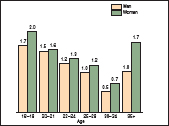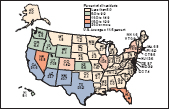16d Considering visuals and media
Choose visuals and other media that will help make a point more vividly and succinctly than written words alone. In some cases, visuals and media may even be your primary text.
 Selecting visuals and media
Selecting visuals and media
Consider carefully what you want visuals, audio, or video to do for your writing. What will your audience want or need you to show? Try to choose visuals and media that will enhance your credibility, allow you to make your point more emphatically, and clarify your overall text. (See the following examples for advice on which visuals work best for particular situations.)

|
Use pie charts to compare parts to the whole. |

|
Use bar graphs and line graphs to compare one element with another, to compare elements over time, or to show correlations and frequency. |

|
Use tables to draw attention to detailed numerical information. |

|
Use diagrams to illustrate textual information or to point out details of objects or places described. |
(BOTTOM) © SOVFOTO/UIG VIA GETTY IMAGES

|
Use maps to show geographical locations and to emphasize spatial relationships. |

|
Use cartoons to illustrate a point dramatically or comically. |

|
Use photographs or illustrations to show particular people, places, objects, and situations described in the text or to help readers find or understand types of content. |
(BOTTOM) © MICHAEL ENRIGHT/WWW.MENRIGHT.COM
Effective media content can come from many sources—your own drawings or photographs, charts or graphs you create, or recordings you make, as well as materials created by others. If you are using media from another source, be sure to give appropriate credit and to get permission before making it available to the public as part of your work.
 Positioning and identifying visuals and media
Positioning and identifying visuals and media
Make sure to position visuals and media clips alongside or after the text that refers to them. In formal texts, number figures and tables separately and give them informative titles. Some documentation styles ask that you include source information in a caption (see Chapters 32–35).
 Making media texts accessible
Making media texts accessible
As you create media texts, take steps to make sure that all your readers can access your content—for example, by providing alternative text for all visuals so that they will make sense when read by a screen reader, and by providing captions for sound files and transcripts of longer audio content. For details on designing accessible texts, visit the Americans with Disabilities Act site at www.ada.gov.
 Using visuals and media ethically
Using visuals and media ethically
Technical tools available to writers and designers today make it relatively easy to manipulate and edit visuals, audio, and video. As you would with any source material, carefully assess any visuals you find for effectiveness, appropriateness, and validity, and identify the source for any media files you use that you have not created yourself.
- Check the context in which the visual, video, or audio appears. Is it part of an official government, school, or library site or otherwise from a credible source (12d)?
- If the visual is a photograph, is the information about the photo believable?
- If the visual is a chart, graph, or diagram, are the numbers and labels explained? Are the sources of the data given? Will the visual representation help readers make sense of the information, or could it mislead them (8e and f)?
- Can you find contact information for the creator or rightsholder?
At times, you may make certain changes to visuals that you use, such as cropping an image to show the most important detail, digitally brightening a dark image, or using a short clip from a longer audio or video file. You can make digital changes as long as you do so ethically, telling your audience what you have done and making no attempt to mislead readers.